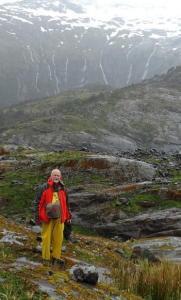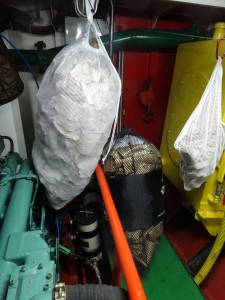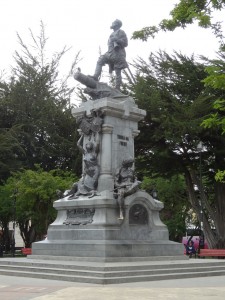From the Field: Bill Buck in Cape Horn 2014, Part 14
Posted in Travelogue on May 27, 2014 by Bill Buck
William R. Buck, Ph.D., is the Mary Flagler Cary Curator of Botany at The New York Botanical Garden. Every January for the past three years, Dr. Buck, a moss specialist, and a team of colleagues have journeyed to the Cape Horn region at the southern tip of South America to document the area’s rich diversity of mosses and search for new species. This is the last in his series of posts about his 2014 field trip.
January 30, 2014; Punta Arenas, Chile

The trip is all but over. We arrived in Punta Arenas at midnight between the 27th and 28th, almost a day early. I asked Ernesto Davis to phone ahead and see if our hotel reservation could be updated. After a rough night the day before, everyone was ready for stable beds and hot showers. Fortunately, the hotel had space and our rooms were ready when we arrived, luggage in hand.
We returned to the ship early the next morning to gather our collections. The entire crew was in attendance when we arrived at the trusty Doña Pilar. We still had specimens on the dryers and promptly started dealing with them. There was little wind, so I was able to close up my paper bags on the deck. Every last one of my collections was completely dry. Everyone else still had damp specimens that would need additional time before being packed up.
Early in the expedition, I asked the crew if, after our trip, I might have the small Magellanic flag that the Doña Pilar flew. Ships on previous expeditions only flew the Chilean flag, which I asked for and received during our last trip. Perhaps they hadn’t flown the Magellanic flag because the captain was from further north, in Chiloé. Regardless, I was delighted when this year’s captain presented me with the tattered flag that had flown over the ship that had served us so well. I collect flags, in part as a true souvenir of my collecting localities. Some hold special memories. I will proudly display this one in my New York office.
We headed for the university after final goodbyes with the ship’s crew. I started boxing my collections, as did Barb Andreas, while the others spread out their damp specimens to dry. By noon, I was ready to go to the post office. Every year we mail our collections home, and they usually arrive without incident—at least until last year. In 2013, most of our packages arrived as expected, but nearly a dozen boxes—including all of my collections and about half of Juan Larraín’s and Paddy Dalton’s—never showed up. All had tracking numbers, and Juan was in frequent communication with the Chilean postal service. After a time, the official Web site listed our boxes as lost.

I decided not to accept our parcels’ fate but to put some effort into finding the lost collections. I first contacted the U.S. Department of Agriculture official at JFK, who frequently uses The New York Botanical Garden’s William and Lynda Steere Herbarium to identify confiscated plants. He assured me they never arrived in New York. I asked him to contact his counterpart in Miami, where mail from Chile enters the U.S. Again we were told that the boxes never arrived.
In desperation, I talked to the head of the Botanical Garden’s mail room, who had previously worked for the U.S. Postal Service. Like a bulldog on a mission, he got right on it, contacting both the Chilean mail service and the USPS headquarters in Washington, D.C. I’m sure I’ll never know the whole story, but within days we received notice that the boxes had entered the U.S. My heart swelled. Against all odds, our collections resurfaced.
I was told that part of the problem might have been due to the fact that the boxes were mailed on a Friday, a bit too close to the weekend. This year, I intended to send my collections out as early in the week as possible. Barb and I got all of our collections and about half of Juan’s and Matt von Konrat’s into the mail on Tuesday.
The drying process continued yesterday for those with moist collections, but by day’s end there were still wet bryophytes. Juan, Matt, and John Brinda returned to the university today—Thursday—to finish up the task and to get the final parcels mailed out. After last year’s experience, I was glad I was already done. Thursday here is often referred to as “little Friday” (viernes chico) because the weekend celebrations start early.
Another presentation about Ernesto’s book is taking place in a downtown hotel this afternoon. I intend to be there to support him. Afterward, Ernesto, his partner Silvia, and the rest of the group will go out to dinner together.

In past years, Ernesto has had us all to his home for a final dinner party, but with his presentation this afternoon and Silvia just home from Spain, I convinced him that this year the entertaining duties would fall on us. Of all the people associated with our expeditions through the years, Ernesto has been the most indispensable. He has soothed officials who wanted nothing to do with us and solved innumerable problems—many of which likely never came to my attention. When he was asked on our first year of the expedition if he would help organize it, he agreed under one condition: that he accompany us on the ship. It wouldn’t have worked any other way.
Ernesto and I have become close friends through the years. As a parting gift, I gave him a Spanish translation of Elizabeth Gilbert’s recent novel, The Signature of All Things, as he is always reading literature.
Most of us will fly to Santiago tomorrow afternoon before scattering to our various destinations. John’s girlfriend has flown down from Missouri, and they intend to go camping in Torres del Paine National Park before heading home. For me, I’ll be relieved to have only myself to look out for, rather than an entire group of independent-minded people. After more than four years, I can relinquish the yoke.
I am sad never to return here, but each time I look at one of my collections I will relive the amazing experiences I have had in what I consider the most beautiful landscape in the world.
Past Expedition Entries:
Photos provided by Barbara Andreas.


Hi Bill,
I have read you account of collecting in T del F with much pleasure – and especially enjoyed the photos.
I have been reading and writing about the British expeditions there in the 1830s, and it’s wonderful to read about people still doing this over nearly 2 centuries later.
Many thanks!!